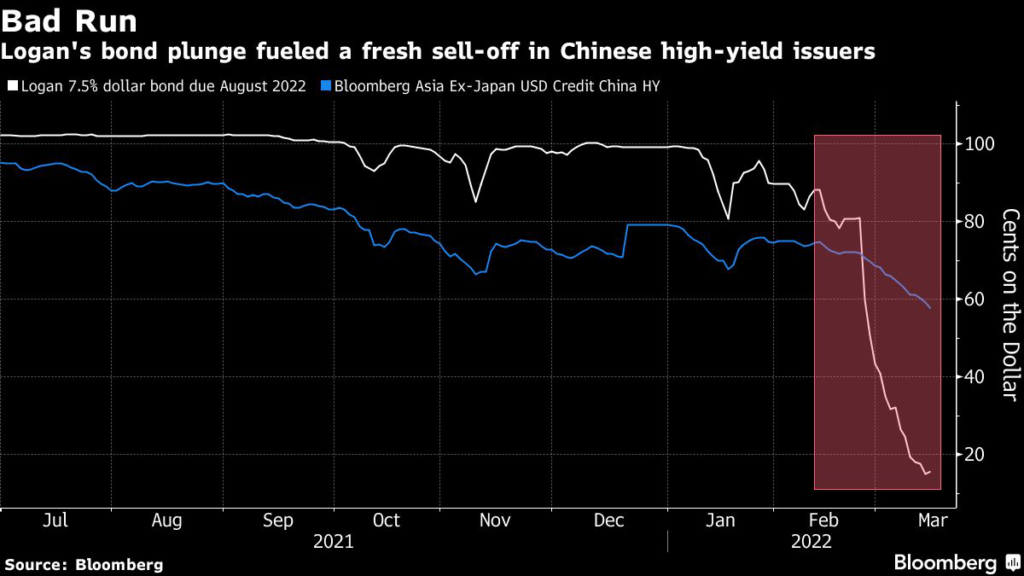(Bloomberg) — What used to be a gold mine for Chinese property developers has become a burden as the industry’s credit crunch intensifies.
Urban redevelopment projects, which turn run-down areas into new properties in big cities, were sought after by developers like Logan Group Co. and Times China Holdings Ltd. in recent years for their prime locations and hefty margins.
Now such works are being scrutinized by investors and credit rating companies for their tendency to house hidden debts through the use of joint ventures and shadow financing. They are also taking longer to complete — sometimes more than a decade — sucking up cash and making it difficult for distressed developers to generate sales in time to soothe angry creditors.
“We are avoiding developers with a high proportion of urban redevelopment projects, at least for now,” said Liu Junjie, a fixed-income fund manager at Zheshang Fund Management Co. “They usually come with liquidity risks and uncertain cost controls.”
Concerns over opaque liabilities tied to such projects prompted UBS Group AG analysts to downgrade shares of Logan, which until recently was seen as relatively immune to the credit crisis engulfing Chinese developers. Logan’s extensive urban redevelopment exposure is the key reason behind off-balance-sheet debt estimated at as much as 1.7 times its reported net debt, UBS analysts led by John Lam wrote in a report last month.
The developer’s bonds — and credit ratings — have plunged in recent weeks on mounting concerns over its financial health, contributing to a renewed sell-off in Chinese offshore junk debt that has seen yields surge to a record.
Times China, which focuses on renewal projects in the Greater Bay Area, was downgraded by Moody’s Investors Service last month, citing reduced liquidity in part due to continued spending on such developments.
Urban renewal projects typically take at least three years before even getting current residents to agree to resettlements, a compulsory first step before construction is allowed to kick off, according to researcher CreditSights Singapore LLC. At that stage, developers typically don’t have access to low-cost bank loans, and often have to seek financing from other channels including private funds and trust companies — common forms of off-balance-sheet liabilities, said Zheshang Fund’s Liu.
And that’s just upfront costs. Heavier expenditure usually occurs later when developers pay chunky re-zoning fees and compensation for residents who need to relocate.
Sometimes, equity investments provided by joint venture partners might turn out to effectively be debt, which constitutes hidden leverage, said Edward Chan, a director at S&P Global Ratings. Some developers even privately guarantee debt issued by these partners.
Builders are increasingly bowing out of urban redevelopment projects as they navigate the credit crunch. Earlier this month, Shimao Group Holdings Ltd. withdrew from an initiative it entered into in 2018. Kaisa Group Holdings Ltd. sold a 49% stake in one in Guangzhou after defaulting on its debt in December. Across the city, at least 16 projects saw shareholder changes last year as developers pared their investment, according to China Real Estate Information Corp.
Representatives for Logan, Times China, Shimao and Kaisa didn’t reply to requests for comment.
Table Turns
Faced with soaring land costs, developers flocked to urban redevelopment works for expansion around the middle of last decade. To improve living standards, local governments allowed builders to sell them at market prices rather than the steep discounts traditionally associated with overhauls of shantytowns into affordable housing.
Gross margins usually surpassed 35% and could reach as high as 60%, according to CreditSights. That exceeded margins at conventional developments, which were being squeezed by home price controls adopted in top-tier cities. Gross margins at listed developers slid to a median 30% in 2020, according to data compiled by Bloomberg.
For small but ambitious builders, urban redevelopment allowed them to grow without having to compete with the biggest players at land auctions. Shares of Logan and Times China climbed more than 300% from the end of 2016 to 2019, more than triple the sector average.
Now, the tables have turned.
With urbanization already at a late stage — by 2020, 64% of the population lived in cities, up from only 36% two decades earlier — China no longer needs endless urban renewal and is now looking to preserve its cultural heritage instead. The housing ministry in August drafted rules to cap the percentage of easy demolition-to-construction works. In December, southern Guangzhou city halted several redevelopments after President Xi Jinping, who has sought to cast himself as a champion of green causes, personally intervened and punished officials for cutting down thousands of banyan trees.
The new rules will lengthen the product cycle even further and may impact the profitability of real estate companies, said Yin Chin Cheong, a CreditSights analyst. That will also delay when projects are ready for sale, dragging on cash inflows, he said.
“Local authorities want to be more deeply involved in these projects,” said Cedric Lai, a senior analyst at Moody’s. “The government doesn’t want to see earth-shaking changes in redevelopment anymore.”
More stories like this are available on bloomberg.com
©2022 Bloomberg L.P.











